
Microplastics have become a major environmental pollutant, infiltrating various aspects of our daily lives, including our beauty routines. These tiny plastic particles are less than five millimeters in size, and are found in tons of cosmetic and personal care products, from exfoliators to shampoos and conditioners. One study analyzing 144 personal care products found that 70% contained at least one type of microplastic.1
Beyond their environmental impact, microplastics may also pose risks to your health, like building up in the body, interfering with hormones, and causing cell damage. Some studies have even found microplastics in human organs, lungs, and blood, raising concerns about their long-term effects. Avoid microplastics by making the switch to plastic-free hair and skin products for a healthier, more sustainable routine.
Understanding Microplastics in Beauty Products
Microplastics in cosmetics primarily come from micro-beads, which were once commonly used in exfoliating scrubs, and liquid plastics that enhance a product’s texture or durability. Here are some of the most common microplastic ingredients found in beauty products include:
-
Polyethylene (PE): A common microplastic used in exfoliants and creams for texture and viscosity.
-
Polypropylene (PP): Found in various cosmetic formulas for texture.
-
Polymethyl methacrylate (PMMA): Adds a smooth finish to foundations and powders.
-
Nylon: Used in mascaras and lipsticks to improve spreadability.
-
Acrylates copolymer: Provides a film-forming effect in hair products, sunscreens, and long-wear makeup.
The Environmental and Health Impact of Microplastics
Microplastics in beauty products are not effectively removed by wastewater treatment plants, which can cause buildup in oceans and waterways. In turn, marine life ingests these particles, harming our environment and potentially introducing toxic substances to our food chain.
Beyond environmental concerns, microplastics may also impact human health. Research suggests that exposure to microplastics can contribute to oxidative stress, inflammation, and toxicity in the body. Studies even link airborne microplastics from cosmetic products and synthetic materials to serious health concerns, including infertility, colon cancer, and respiratory diseases.2
Global Regulations and Industry Response
In response to the growing concern over microplastics, the U.S. implemented the Microbead-Free Waters Act of 2015 banned the sale of rinse-off cosmetics containing microbeads. In Europe, several brands have followed suit, but many cosmetic and hair care products still contain liquid plastics that slip through regulatory loopholes. This makes it challenging—but essential—for consumers to stay informed and choose truly sustainable beauty brands.
How to Avoid Microplastics in Beauty Products
If you're looking to transition to low waste skincare and eco-friendly hair care solutions, here are steps to take:
1. Read Ingredient Labels Carefully
Here are common microplastic ingredients in skincare, makeup, and even haircare products like shampoos and conditioners. Avoid products that contain:
-
Acrylate Copolymer (AC)
-
Polyethylene (PE)
-
Polypropylene (PP)
-
Polymethyl methacrylate (PMMA)
-
Siloxane
-
Polyquaternium (PQ)
2. Choose Microplastic-Free and Organic Alternatives
Many biodegradable beauty products now use natural ingredient alternatives instead of synthetic beads. Look for natural exfoliants for skin, such as:
-
Sugar
-
Salt
-
Coffee grounds
-
Oatmeal
-
Apricot seeds
3. Opt for Plastic-Free and Climate Neutral Products
A simple way to reduce waste and make a sustainable choice is to switch to plastic-free products. Certifications like Climate Neutral indicate that a company is actively measuring, reducing, and offsetting its carbon footprint and use of plastic. Choosing brands committed to sustainability helps support eco-friendly beauty.
For example, The Earthling Co. is proud to be Climate Neutral Certified, meaning we account for all emissions from our business operations and have a plan in place to reduce them. We also keep packaging minimal, using recyclable and compostable materials like unbleached kraft paper for a lower carbon footprint.
4. Use Apps to Check Products
Tools like the Beat the Microbead app make it easy to scan products and see if there are hidden microplastics in your products.
5. Support Sustainable Beauty Brands
Many clean beauty brands are committed to sustainable packaging, vegan formulas, and cruelty-free testing. Brands that prioritize eco-friendly skincare routines also avoid harsh chemicals like parabens, sulfates, and silicones.
At Earthling Co., we focus on simple, effective products that cut through the clutter. Our Shampoo and Conditioner Bars are made for all hair types, using clean, non-toxic ingredients that actually work, without unnecessary additives or excess packaging. Sustainability starts with better choices, and we make it easier to build a routine that’s both low-waste and high-performance.

The Future of Eco-Friendly Hair and Skin Care
Microplastics are a hidden component in many beauty and haircare products, posing environmental and potential health risks. By staying informed and making conscious choices, you can significantly reduce your exposure to microplastics in cosmetics.
Make the switch to sustainable beauty brands, using biodegradable skincare and haircare, and support initiatives that contribute to a greener beauty industry. Whether it’s choosing the best eco-friendly shampoo, investing in microplastic-free skincare, or reading labels carefully, every small change makes a difference.
The Earthling Co. is proud to offer thoughtfully designed, low-waste personal care products that help simplify your routine while reducing plastic waste.
Explore our collection of eco-friendly shampoo, conditioner, and skincare essentials. Shop now and make the switch to sustainable self-care.





